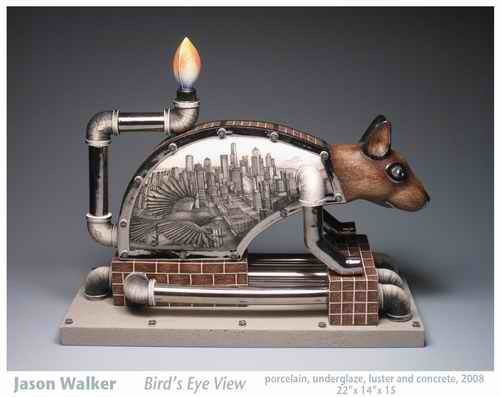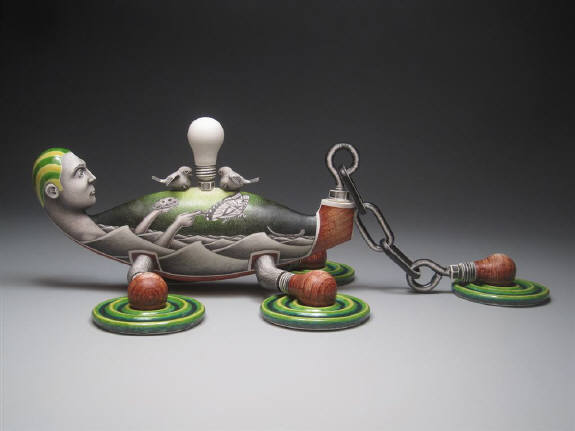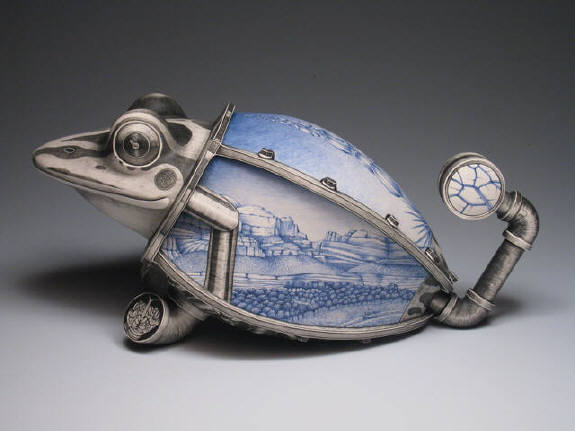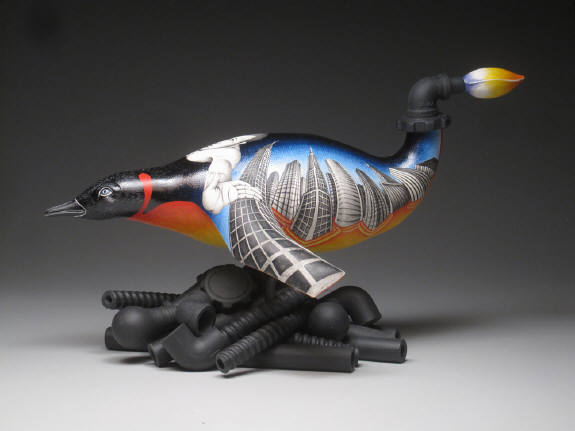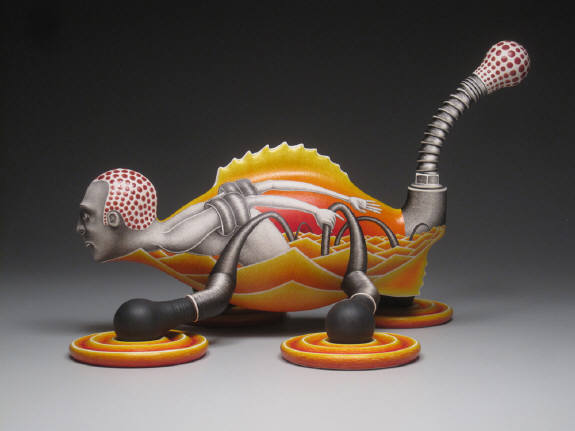WEBSITE: JASON WALKER
IMAGES: JASON WALKER GOOGLE IMAGES
CONTACT:
- 3261 Robertson Rd.
- Bellingham, WA 98226
- (home and studio) 360-739-8897
- jasondeloswalker@hotmail.com
- Education
- 1999 MFA degree, Pennsylvania State University, State College, PA
- 1996 BFA degree, Utah State University, Logan, UT
- Currently teaching at Emily Carr University, Canada
From Jason Walker Website:
In my ceramic sculpture, I have been exploring American ideas of nature and how technology has changed our perceptions of nature. Besides the obvious advantages technology may bring to our lives, there lie unintended consequences and underlying messages behind every creation that forever change our perceptions, our social interactions and our relationship to nature. The word nature itself has become an overused term in our present ideology to the degree it has altogether lost its meaning. What is nature exactly? How do we perceive and define it, and why? In Webster’s dictionary nature is defined as, “something in its essential form untouched and untainted by human hand’. Here lies the crux of my narrative. At the very heart of our description of nature we exclude ourselves from it and place human beings outside of nature. In America we hold tightly to this dualistic view. A view that has created two separate worlds – the human made world and the non-human made world – or in other words the dichotomy between culture and nature. The way we perceive nature speaks volumes about the way we perceive ourselves and becomes a major component in defining what it means to be human at this precise moment in history. A place that embodies our most ideal perception of nature is wilderness. Speaking of wilderness William Cronon wrote, “For Americans wilderness stands as the last remaining place where civilization, that all too human disease, has not fully infected the earth. It is an island in the polluted sea of urban-industrial modernity, the one place we can turn for escape from our own too-muchness.”
Paradoxically, from our ‘our too-muchness’ our ideas of wilderness are conceived. I have come to realize my own appreciation for nature has come from the culture of which I belong. Ultimately, ideas of nature and/or wilderness are human constructs ever changing through human cultures at different moments in history. Presently, it is time to rethink our perceptions of nature, culture, wilderness and civilization and perhaps we may once again reinstate our own naturalness and, one day, find balance between the planet and ourselves. Ultimately, in doing so we may come to a better realization of what it means to be human at this present time.
express the way in which technology has influenced our perceptions of nature. I developed a narrative based on the historical progression of our changing perceptions of ‘nature’ and ‘wilderness’ in America.
I titled the show ‘Nature Seeker’ because I think we use term nature very loosely in our language today, and as I hiked I felt as though I was seeking a place or an object that embodied the word nature. According to Webster’s dictionary, nature is something in its essential form untouched and untainted by human hand. So here lies the crux of my quest. At the very heart of our own description of nature we exclude ourselves from it. Does this mean I am not natural? Although this argument may seem purely semantic it is not. The way in which we perceive nature inadvertently describes the way in which we perceive ourselves. Ultimately, my quest is a journey to define for myself what it means to be human in the present time.
2007
General Artist Statement:
The culture I live in does not emphasize our physical connection and dependence on nature. The current ideology is reliant upon technology, and it promotes disembodied activity such as television [and] computers . . . The gap between man-made and natural is ever increasing.
Light bulbs, plugs, power-lines and pipes that grow from the earth are common images found in my work, juxtaposed with birds, insects, and organic matter such as leaves and trees. Similar to the thinking of the Hudson River School of painting, I attempt to portray nature’s vastness and human-kind as a small proponent of it. Yet I draw the small things of nature large and the huge creations of man small. I want to show how we influence the landscape, or nature. My ideas stem from my own experiences bicycle touring, backpacking and the daily hikes I take with my dog.
LINKS: Jason Walker’s “Timing Chain” by Paul Mathieu, NCECA PDF
Ceramics, as a distinct and autonomous art form, implies the coming together of a form and a surface.
This form generally (if not always) is volumetric in nature, that is to say that it is hollow inside and has been generated from the inside out, as a volume. The surface, whatever quality it takes, although it may describe the volumetric form, as it does here, remains distinct from the form itself, as it does here, as well. The surface is another layer of information added to the form. Only ceramics behave in such a fashion in all art disciplines and these characteristics are specific to ceramics (and pottery) as art forms.
The fact that the object is made with (fired) clay is of some importance too, but I would argue that it is not, by far, the most important aspect to define an object as ceramics. Conceptual aspects like a volumetric form and a distinct surface are much more important than mere material. In fact, in the object under discussion here and in Jason Walker’s work in general, the “clayness” of the work is of little significant importance, for a variety of reasons. For example, there is little if any obvious tactility perceivable, a characteristic so often found in objects made with clay. The various forms used in this assemblage do not specifically refer to the vocabulary of forms usually found in the ceramics lexicon.
We are confronted here instead with a variety of geometric forms combined with mechanical parts, all referring or imitating metal, as well as a stylized duck head. The teapot connection, somewhat ambiguous anyway, is the only obvious connection to ceramics we have here. The “teapotness” of this object serves to give it a clear identity, as a thing that can be clearly named, an identity that would be confusing otherwise. This is also a strategy (efficient but hypocritical) employed by much contemporary ceramics, to gain instant meaning through identity and identification, meaning which would be much poorer to inexistent otherwise. The ambiguity of this object as a ceramic object is also manifest at the level of surface, which remains graphic and illustrative, with no readily identifiable ceramic aspect (it imitates drawing or prints imitating metal) and has none of the expected shininess, fluidity, depth and reflectivity of glazes, for example. In fact, this object could be made of plastic.
Going as far back as Bernard Palissy in 16 th Century, France (whose work, in connection to Walker’s, was also informed with natural references related to ecology, in an illusionist manner), but certainly since the middle of the 19th Century, hand made pottery and ceramics were largely made for the personal, expressive needs of individuals. Going from the practical to the personal, ceramics now finds itself at a junction point where it desperately needs to rethink its identity and role within culture, since we have no real needs anymore for practical objects made by hand and we have all experienced the inherent limitations of personal expression in generating new forms and new meanings, beyond self indulgence.
I propose that due to its particular properties (its resistance to time), ceramics is the best archival material ever devised by humankind. Thus, the ceramics we now make will become the archives of the future, like all the ceramics made before. This archival nature of ceramics is probably its most potent claim to meaning
NATURE SEEKER
In an attempt to explore the methods of early American artists, such as Moran and Cole from the Hudson River School of Painting, I went to an American ‘wilderness’ and backpacked solo with my sketchbook for ten days. The landscape, plant and animal imagery are records from my experience in the Grand Staircase – Escalante National Monument in the desert of southern Utah. The technological imagery is a record of objects in my everyday experience and is used to within culture, beyond its practical aspects and certainly beyond its individual potential for personal expression.
Jason Walker’s “Timing Chain”, a non-functional object with limited personal individuality (there is an anonymity to both the forms and the surfaces), with its references to the hybridity of opposing realities, the mechanical versus the natural, comments on our present schizophrenic relation to the world and as such is an efficient archive of our present state of mind as a species. It will transmit that information efficiently. By being aware of this archival potential, it is my hope that Jason Walker will take this responsibility, as will others, with all the seriousness it deserves.
Paul Mathieu is a potter presently living in Vancouver, Canada, where he teaches ceramics at Emily Carr University. He is presently completing a new book, “The Art of the Future: 14 essays on ceramics”.
Which will soon be available on his website at www.paulmathieu.ca


